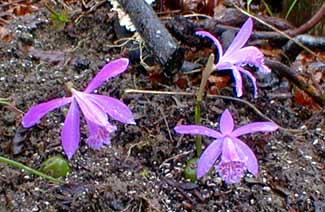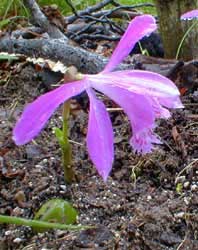
Hardy Terrestrial Orchid
The directions one can find for carring for the terrestrial orchid Pleione bulbocodioides makes it sound difficult to grow, as most orchids are. But for those of us in the Pacific Northwest, we have a good chance of getting them to naturalize right in the garden without all the special care elsewhere required. Indeed, the care instructions for our region could be summed up as "plant bulbs so shallow the top sticks out of the ground, & mulch to protect it in winter."
Native to China, Nepal, Tibet & Taiwan, in the wild they grow in moss either on the ground or on rocks or sometimes up in trees like regular epiphytic orchids. They are cold hardy to about five degrees F, lower when protected by snow or mulch. They require radically good drainage, so ours are planted right at a little garden ledge, which not only drains well, but the roots of a Rohani beech tree sucks up any excess wetness. Soil should be kept barely moist in spring, with periodic doses of liquid fertilizer throughout the spring bloom period.
 If left in the ground they are at some risk of rotting during normal summer watering. We'll won't know until next year if they were adaptable to the conditions we've provided! When the bulbs have finished, they will still have a single leaf apiece for some while. Meadow rue & a hardy geranium share this general vicinity, but they're types that don't really show themselves much until May, so while in peak bloom the orchids have the spot mainly to themselves.
If left in the ground they are at some risk of rotting during normal summer watering. We'll won't know until next year if they were adaptable to the conditions we've provided! When the bulbs have finished, they will still have a single leaf apiece for some while. Meadow rue & a hardy geranium share this general vicinity, but they're types that don't really show themselves much until May, so while in peak bloom the orchids have the spot mainly to themselves.Pleonies & Bletillas are the easiest of all temperate orchids to grow; but all things being relative, they should be categorized not so much as Hardy Orchids, but as Almost Hardy Orchids. The spherical green pseudobulbs each produce one or two flowers. With proper fertilizing during the spring, they should not only flower with extravagant brightness, but also produce two or three new pseudobulbs for the following year, which will germinate in winter when the temperature falls to freezing. The older bulb is spent & in pot-cultivation it would be discarded, but the plan for our two specimens is to see if they'll manage on their own, as they certainly would do on a mountainside in Nepal.
To grow them as a sure-thing for years, reading up on its more elaborate needs is certainly to be recommended. But enough people have had luck planting them & letting them mainly take care of themselves, that that's why we've put them into light shade in a radically-well-draining location that self-mulches with beech leaves. If this works out, & they do naturalize, I'll be so very pleased, but at worst, we've had some stunning blooms for one spring.